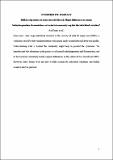Por favor, use este identificador para citar o enlazar a este item:
http://hdl.handle.net/10261/166872COMPARTIR / EXPORTAR:
 SHARE
BASE SHARE
BASE
|
|
| Visualizar otros formatos: MARC | Dublin Core | RDF | ORE | MODS | METS | DIDL | DATACITE | |

| Título: | Milk fat depression in dairy ewes fed fish oil: Might differences in rumen biohydrogenation, fermentation, or bacterial community explain the individual variation? |
Autor: | Frutos, Pilar CSIC ORCID ; Toral, Pablo G. CSIC ORCID ; Belenguer, Álvaro CSIC ORCID ; Hervás, Gonzalo CSIC ORCID | Palabras clave: | Acetate Fatty acid Marine Lipid Ruminal microbiota Sheep |
Fecha de publicación: | 2018 | Editor: | American Dairy Science Association | Citación: | Journal of Dairy Science 101: 6122-6132 (2018) | Resumen: | Dairy ewes show large individual variation in the extent of diet-induced milk fat depression (MFD) but reasons behind this variability remain uncertain. Previous results offered no convincing support for these differences being related to relevant changes in the milk fatty acid (FA) profile, including potentially antilipogenic FA, or in the transcript abundance of candidate genes involved in mammary lipogenesis. Therefore, we hypothesized that alterations in the processes of rumen biohydrogenation and fermentation, as well as in the bacterial community structure, might account for individual variation in fish oil-induced MFD severity. To test this explanation, 15 ewes received a total mixed ration without lipid supplementation (control; n = 5) or supplemented with 20 g of fish oil/kg of dry matter [10 animals divided into those showing a strong (RESPON+; -25.4%; n = 5) or a mild (RESPON-; -7.7%; n = 5) decrease in milk fat concentration] for 5 wk. Rumen fermentation parameters, biohydrogenation metabolites, and bacterial structure and diversity were analyzed in rumen samples collected before and after treatments. Although the fish oil supplementation increased the concentration of demonstrated or putative antilipogenic FA (e.g., cis-9 16:1, cis-11 18:1, or trans-10,cis-12 CLA), surprisingly, none of them differed significantly in relation to the extent of MFD (i.e., between RESPON- and RESPON+), and this was the case only for a few minor FA (e.g., cis-6+7 16:1 or 17:0 anteiso). Changes in total volatile FA, acetate, and propionate concentrations were associated with MFD severity, with higher decreases in more susceptible animals. Individual responses were not related to shifts in rumen bacterial structure but some terminal restriction fragments compatible with Clostridiales, Ruminococcaceae, Lachnospiraceae, and Succiniclasticum showed greater abundances in RESPON-, whereas some others that may correspond to Prevotella, Mogibacterium, and Quinella-related spp. were more abundant in RESPON+. Overall, the results suggest that individual variation in MFD severity in dairy ewes fed fish oil cannot be fully explained by differences in the processes of rumen biohydrogenation and fermentation or in the bacterial community, and further research would be necessary to elucidate the large variability in the responsiveness to MFD-inducing marine lipids. Copyright © 2018 American Dairy Science Association. Published by Elsevier Inc. All rights reserved. | Descripción: | 11 páginas, 4 tablas, 1 figura. | Versión del editor: | http://dx.doi.org/10.3168/jds.2018-14632 | URI: | http://hdl.handle.net/10261/166872 | ISSN: | 1525-3198 |
| Aparece en las colecciones: | (IGM) Artículos |
Ficheros en este ítem:
| Fichero | Descripción | Tamaño | Formato | |
|---|---|---|---|---|
| Frutos et al_2018_RESPO-Rumen post-print.pdf | 660,89 kB | Adobe PDF |  Visualizar/Abrir |
CORE Recommender
Page view(s)
363
checked on 15-abr-2024
Download(s)
196
checked on 15-abr-2024
Google ScholarTM
Check
NOTA: Los ítems de Digital.CSIC están protegidos por copyright, con todos los derechos reservados, a menos que se indique lo contrario.
